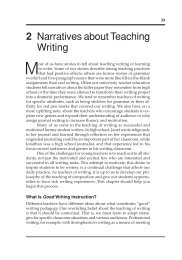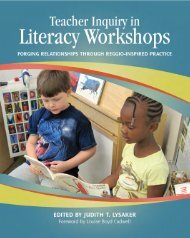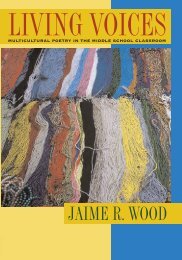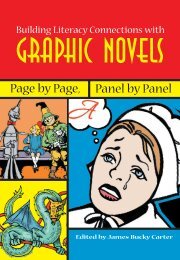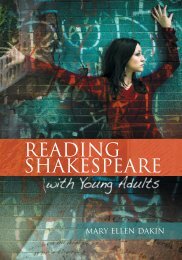1 Everyday Poets
1 Everyday Poets
1 Everyday Poets
Create successful ePaper yourself
Turn your PDF publications into a flip-book with our unique Google optimized e-Paper software.
<strong>Everyday</strong> <strong>Poets</strong> 11 <strong>Everyday</strong> <strong>Poets</strong>Poetry—merely whispering its name frightens everyone away” (43),says former Poet Laureate Rita Dove. Poetry frightens many of mystudents because it conjures up images of the impossibly distantpast—like speaking Babylonian or medieval tournament jousting—nottheir immediate lives right here, right now.But poetry is not a past-tense activity. Poetry is around us all thetime—why, right now it’s in this room in what we see, hear, taste, touch,and smell; it’s on the radio in song lyrics and raps; it’s on the playgroundin jump rope chants and basketball trash talk; it’s in everyday conversations,in the things that go unsaid and in the things we don’t yet havethe words to say. Poetry is already in our lives, and poetry can help usmore fully participate in our own lives and in the lives of others.While I know that only the rare student will aspire to become aprofessional poet or a career writer, I want my students to see theirwriting as part of their lives, not an end in itself. To do this, we musteliminate, in John Dewey’s words, “the gap between the child’s experienceand the various forms of subject matter that make up the courseof study” (Selected 344). Poetry writing allows their experiences to be thecourse of study.Poetry instruction in schools often feels artificial, consisting oflittle more than gimmicky exercises that have no audience but theteacher and no life outside the classroom. Such formulaic exercises havelittle to do with poetry because they have little to do with life. As LouiseRosenblatt has argued, literature needs to be “rescued from its diminishedstatus as a body of subject matter, and offered as a mode of personallife experience” (x).In this book, I present some ways teachers can use students’ personallife experiences to (1) help students become less afraid and morecomfortable with poetry and (2) help students see how poetry writingand performance connect to their lives and how poetry can enrich theirlives.In My LifeMy students’ attitude toward poetry as something distant and frighteningis an attitude I know well. Their feelings parallel my own experienceswith poetry.
<strong>Everyday</strong> <strong>Poets</strong> 3demands, or if I was pressed for time. The poems my students wrotewere often formulaic gimmicks found in textbooks: acrostic and anagrampoems, limericks, and haiku taught in the rigid 5-7-5 syllablemode. My students were as terrified as I was to try their hands at “realpoetry.”It’s not hard to find the source of this fear. I’m looking at a literaturetextbook right now that has reprinted Shakespeare’s Sonnet 18 withan activity below: “A sonnet is a 14-line poem written in iambic pentameter.Try one of your own.” Reading a prompt like this, whowouldn’t conclude that poetry is reserved for geniuses?Inspired by school visits from poets such as Luis Rodriguez andNaomi Shihab Nye, however, I started to read more contemporary poetry.The immediacy of poets reading their own work was exciting. Idecided to read whatever I liked, to let the poets I enjoyed reading recommendother poets to read, and never to apologize for putting asidea poem I didn’t like or understand.Like many of my students, I also listened to contemporary music.(I play the guitar and used to select the music for a folk music radioshow.) I especially loved songwriting with thoughtful lyrics: Bob Dylan,Melissa Etheridge, Ira Gershwin, Chuck D, Dave Frishberg. So I decided(as I knew many teachers had before me) to use pop songs as a meansof understanding poems. I’ll never forget how a student namedBuddy—who had very little interest in school—created a slide show ofhis own photographs to illustrate the differences between Paul Simon’s“The Sound of Silence” and a Gwendolyn Brooks poem about urbanChicago. Or how Angel—“a gangbanger who’ll never graduate,” I’dbeen told—compared generational attitudes toward fathers in DylanThomas’s “Youth Calls to Age” with a rap song by Sir Mix-a-Lot. I feltlike I was really on to something: My students had a great deal to sayand a desperate urge to express themselves. Poetry gave them the voiceto do this.I read everything on teaching poetry I could find. I especially likedKenneth Koch’s books (such as Rose, Where Did You Get That Red?; Wishes,Lies and Dreams; and Sleeping on the Wing, with Kate Farrell) and beganhaving my students write poems in imitation of famous poets. Havinga good model to follow is as effective in writing poems as it is for everyother kind of writing. But writing “in the style of” another poet is necessarilylimiting. Many books left me frustrated by their vague directions(“Write about a special dream”) or suggestions that seemed tooverdetermine the resulting poem (“Write a poem about a physical traitof yours you wish you could change”). The variety and creativity of my
4 Chapter 1students’ work always reminds me how important it is to give studentsa range of models (moods, forms, ideas) for each poem assignment sothat they have a chance to write about something they are passionateabout even if it means leaving the models behind.One day, when I told the class they’d have fun writing their nextpoem (a poem requiring them to interview a friend), a student said, “Ifit’s so much fun, you do it.” I did, and have tried every assignment Ihave given since. Writing poems with the class has helped me understanddifficulties inherent in the assignment. It also creates tremendoustrust with my students, who see me working alongside them. If it’sworth my time, it must be worth theirs, they seem to say. More thanthat, I really have fun writing these poems with my students—the kindof fun I had as a boy, playing alongside Dr. Seuss. And I am very proudof some of what I have written, even if not all of my poems are entirelysuccessful.Pride is clear in what my students write too. At the end of the year,they routinely report that, of all the writing they do, they are most proudof a single poem they have written. By writing poems, my students havenot only studied literature, but they have also created it. And, at the endof the day, their feeling of accomplishment is what I am most proud of.Teaching PoetryI don’t write poems. Actually, I used to write poems, but I can’twrite anymore. (I’ve tried.) You’d have to be a wizard or something,and magic is something I’m kind of short on these days!—grade 10 studentThis student was responding to a questionnaire I passed out on the firstday of school. One of my first goals every year is to demystify poetrybecause this student, like many of my students, enters the class convincedshe lacks the requisite capacity for literary wizardry. Yet herwriting does possess a sort of magic. She uses a metaphor (though interestinglyshe changes the pronoun from “I” to “you” in describing thehypothetical word wizard). Also, she uses a figure of speech in imaginingthat an abstract quality like magic can be something she could runout of. And yet she is scared by poetry.To minimize my students’ fears, I begin my classes by asking studentsto play around with words. As poet Donald Hall says, “All poetsstart from love of words and wordplay” (69). My initial poetry writingexercises (starting in Chapter 2) begin with everyday words and phrases:ice cream brands, album titles, common objects found around the house.
<strong>Everyday</strong> <strong>Poets</strong> 5These activities are designed to demystify poetry and to build confidence.These early exercises are shorter (single-word lines, relativelysimple lists) than later assignments for several reasons. Students findshort assignments less daunting, and everyone can write and have fun withthese poem exercises. Also, very short poems ensure immediate feedback.With everyone’s short poems on the board, we can ask specific questionstogether: Why start with that word? What if you switched thesetwo words? Students spontaneously revise and rearrange on the spot.Since all of the exercises that follow build on previous assignments,this book can be used to guide a full unit of poetry; however,the exercises also work independently as discrete lessons. Dependingon students’ ages and abilities, teachers can choose the exercises thatbest fit their curricula. In my classes, as students grow more confident Igradually ask them to write longer, more complicated poems. Thesepoems will be less intimidating because students can use skills they haveaccumulated from earlier exercises and because we work from modelpoems written by professional poets and by fellow students alike.Using ModelsMost of the poetry exercises in this book are derived from patterns I’venoticed in poems I love. The “sliding doors” poem in Chapter 7, forexample, comes from Billy Collins’s “I Go Back to the House for a Book”and from David Hernandez’s “Sun-Times.” The speaker in Collins’spoem reflects on how his life is different, richer, because of a decisiveaction he took. Hernandez’s hilarious poem shows the consequencesof not acting. This speaker averts a nuclear holocaust and saves theworld by deciding against stealing his neighbor’s newspaper.I give several student models alongside the professional modelswith each assignment. Here I agree with Joseph Tsujimoto, who saysthat “giving students many examples, by both students and adults, canactually encourage original poetry” (10). Offering diverse models suggestsa greater number of possibilities to students, forces them to negotiatewhich forms and patterns will help them best convey theirthoughts, and eliminates the notion that there is somehow a “right answer,”a model to be followed exactly. (Note: Most of the student modelsin this book come from my English classes, grades 8–12, at the Universityof Chicago Lab Schools. I have also included some samples fromelementary school and junior high poetry classes I have taught duringthe summer. These classes included students from public and private
6 Chapter 1schools throughout Chicago. I do not usually tell my students the agesof the authors—unless they ask—and I have used these models in classesand workshops with students who have ranged in age from eight toeighty.)The Teacher as CoachBecause I want students to see poetry as something useful and vital intheir lives outside of school, I see my role as that of a coach rather thana critic. I stand on the sidelines with students—not across the desk fromthem—helping them consider the best strategies for reaching their variousaudiences and writing aims. Since I am not necessarily their intendedreader, I am not the final arbiter of whether a poem is effective;however, I’m happy to tell students what I think of the choices they’vemade and how successfully their poem achieves their desired effects. Itry to phrase suggestions as questions: Can you say this in fewer words?Is it necessary to repeat this idea here? Why did you choose to switchtenses in the second stanza? Will the lack of punctuation here confuseyour readers?I don’t assign letter grades to poems, but this is not because I don’tbelieve that poems can be judged. Rather, I mark poems with a +, a √,or a √- in terms of their completeness. Rather than say, “Yes, this is a greatpoem” or “No, this one isn’t any good,” I say, “Great job! This poemfully completes the assignment and was lots of fun to read,” or “This isa good start, but the second section needs to be developed more fully.Let’s revise this together.”RevisionI allow students to revise their poems as many times as they like. Thisminimizes their fears of “making mistakes,” and it encourages kids totake risks, to try new ways of using language. Even students who rarelyrevise write more boldly knowing the safety net of revision hangs beneaththem. (Note: I’ll briefly outline my feelings toward revision here,but I offer a longer discussion and much more specific classroom strategiesin Chapter 9.)Poet Mary Oliver says she usually has to “revise through fortyor fifty drafts of a poem before [she] begins to feel content with it. Otherpoets take longer” (111). While I confess I don’t usually revise my owndrafts fifty times, I have never written anything that has not undergonesubstantial revision after the initial draft. I tell my students about thetime I had to rewrite a five-word haiku twice before a literary editor
<strong>Everyday</strong> <strong>Poets</strong> 7accepted the poem. Students deserve the same opportunity to keepshaping a piece until they and their readers are satisfied with it. WhenI mention this revision policy to teachers, they sometimes gasp: “Youmean every student can revise everything as often as they want?” Yes,but the number of takers is very small, partly because my students don’twant to increase their own workload, and partly because I insist onmeeting briefly with students to find out why they are interested in revising.If a student wants to revise merely to fulfill the assignment, Imight have him or her revise a portion of the poem (“Rewrite two sensorydescriptions,” for example, or “See if you can rewrite the first stanzausing half the number of words”). If, however, the student poet is genuinelyinterested in revising the poem for his or her own sake (like thegirl last year who said she wanted to keep writing to find out why hergrandmother’s music box mattered so much to her), I am happy to lookat multiple drafts. It is not common for students to be so intrinsicallymotivated. Many students consider substantial revision only when theyare preparing a final draft for publication. For this reason, our writingassignments culminate in publishing classroom collections as well asbooks written by individual authors.Author-izing StudentsCreating books of poems is a great way for students to see their workin new ways and a great way to help students see themselves as poets.My students publish collective “class books,” and individual books aswell. Both kinds of publishing help to achieve Dewey’s unifying aim ofeducation: “the growth of the child in the direction of social capacityand service, and his more vital union with life” (Selected 80). In otherwords, publishing books lets students do the work of professional writersand also face the same challenges these writers face.In compiling class books, it is essential that everyone submit thesame number of poems, or perhaps the same number of pages, sincethe length of poems varies dramatically. This page limitation forces studentsto review their body of work and to choose those poems suitablefor a more general audience. Writing books helps to turn the classroominto a community of writers, and it gives students with different skills—word processing, layout, drawing—a special chance to excel.Writing individual books has become another hugely importantpart of my course. For years I asked students to maintain writing portfolios,file folders stuffed with multiple revisions of poems. Then oneyear an eleventh-grade student whose father had died during the
8 Chapter 1middle of our poetry unit showed me how to use these folders in a moresignificant way. Although this boy missed a lot of school, he wrote agreat deal during this time, and he found poetry to be an important releasefor his new and overwhelming feelings. When he turned in all hismissing work, he had entitled his folder “Reflections in a Cracked Mirror,”and he wrote a letter of introduction explaining the source of someof the poems and a rationale for the order in which he had placed them.This student showed me how the process of collecting poems couldimitate the work professional poets do: selecting and ordering poems,titling their collections, explaining their sources, and offering a statementof introduction. Perhaps most important, this project gives studentsa chance to revisit their work, retrace their thoughts over an extendedcreative period, and measure their growth as writers. Studentsare often amazed at the topics they’ve chosen to return to: a grandmother,a favorite pet, friendships, dreams.My students do not have to copy and bind these books, but theirsense of accomplishment is great nonetheless. The books are a testamentto the work they have done, not only the written work but also the workof discovering themselves and the world around them more fully. Theirpride is as clear on their faces as it is in their writing.At one point, several students started an online journal called ThePaper Tango. The journal, as the students described it, encouraged submissionsfrom all students—they even solicited electronic manuscriptsfrom students at other schools. Their goal was to reach a wider audience,and they encouraged comments on any and all poems they posted.The only stipulation they made was that only a reader who had submitteda poem could comment on the poetry of others. They also wentout of their way to let readers know that “all work posted on The PaperTango is work in progress.” They emphasized writing as a process andsaw poetry as a means of building a larger community of writers andsharing their ideas with an audience outside the classroom.Poetry and PerformancePoetry is too often taught as a solipsistic act: something to be done inprivate, like keeping a secret diary, with no regard for an audience beyondthe poet. As Stanley Kunitz has pointed out, however, poetry“must be felt to be understood, and before it can be felt it must be heard.<strong>Poets</strong> listen for their poems, and we, as readers, must listen in turn. Ifwe listen hard enough, who knows? We too may break into dance” (qtd.in Janeczko 74). Performing poetry offers students the opportunity tocelebrate language through a wide range of media, including the instru-
<strong>Everyday</strong> <strong>Poets</strong> 9ment of their own voices.This celebration of language is what Dana Gioia urges in his bookCan Poetry Matter? Essays on Poetry and American Culture:The sheer joy of the art must be emphasized. The pleasure of poetryis what first attracts children to poetry, the sensual excitementof speaking and hearing the words of the poem. Performancewas also the teaching technique that kept poetry vital forcenturies. Perhaps it holds the key to poetry’s future. (23)Much of the excitement and vitality in my classes comes when studentsdiscover their own reading voices and reinvent their own language inorder to communicate their most important ideas and feelings.Students need as much positive feedback and encouragementwhen reading poems as they do when writing poems. So we applaudevery reading. Applause goes a long way toward creating a communityof writers and reminds students they are not merely writing poemsfor class. They have a larger audience (and an adoring public!).In my classes, each poem is read twice, once by the author andthen by a classmate. Students learn about their own poems through thedifferences in the readings—changes in tone, different ways of readinglines, punctuation. It is important to move outside the classroom as well.At most poetry readings, the audience sits quietly for thirty minutes oran hour and applauds only at the end. The audience is expected to attendwith silent reverence, as though at a church service. (This mayexplain why some poetry readings—and some church services—are sopoorly attended!) Wordplaygrounds ends, as my classes do, with suggestionsfor organizing public readings, dramatizing poems, and integratingpoetry with other disciplines.The school day is so fragmented that it is easy to forget how isolatedour classes can become and how chaotic and random much of ourstudents’ learning must seem to them. Dewey argued that “school as awhole is [to be] related to life as a whole” (Selected 80). We need to findways of connecting disciplines and working on common rather thancompeting academic timetables. Finding common areas of interest andstudy will not only help our students make more sense of their learningbut also help us all remember why our work matters so much. Mystudents learn quickly that poetry is not something foreign to their experience;it is their experience. Poetry offers students the opportunityto explore their language, their world, and themselves more deeply thanthey otherwise would. Perhaps most important, writing and performingpoetry help my students see that they are not just studying literature,they are also creating it.
10 Chapter 1Poetry, my students come to understand, is not something to fear,but rather an invitation to participate fully in our everyday lives. Here,for example, is the advice of one student who entered the class convincedhe “could not ever write a poem”:Don’t Be AfraidWriting poetryIs not as daunting as it sounds.All you have to have doneTo write poetryIs to have lived.I’m alive,So I can write poetry.Anyone reading this is presumably alive;Therefore, you tooAre capable of writing poetry.Once you establishThat you are, in fact, alive,Your poetry may be governedBy your mood. If you’re hungry,For example, there’s an excellent chanceThat your poem will reflect your hunger.Some choose to be coy with their meaningsAnd highfalutin’ with their language(“Bubbles in an IV loitering” or“Museums mark their bodies down”)This is okay sometimes,But you don’t want to hideYour poem’s meaningFrom the reader altogether.Do you understand nowWhy writing poetry is not as hardAs you thought?Proof of life, mood, language:Three simple stepsAnd your poetryWill flowLike water.—Rob, grade 10



